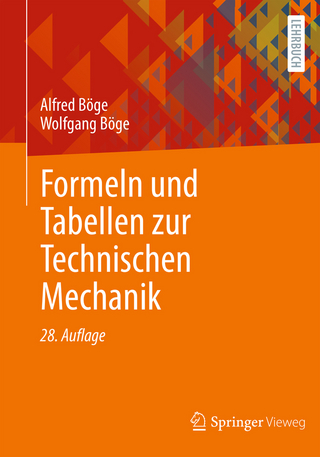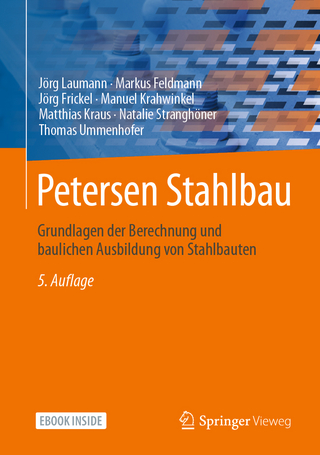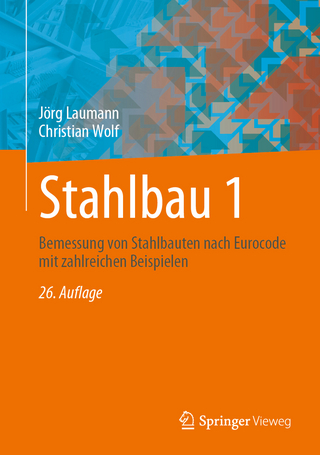Ballastless Tracks
Ernst & Sohn (Verlag)
978-3-433-02993-0 (ISBN)
The authors are extensively involved in planning, operating and inspecting, designing and testing as well as updating specific rules as well as R&D. Univ.-Prof. Dr.-Ing. Stephan Freudenstein has been a full professor at the Chair and Institute of Road, Railway and Airfield Construction at the Technical University of Munich and director of the test institute of the same name in Pasing, Munich, since 2008. After graduating in civil engineering at TU Munich in 1995 and working at Heilit + Woerner Bau AG, Stephan Freudenstein became a research associate at TU Munich's Chair and Institute of Road, Railway and Airfield Construction in 1997. In 2002 he joined Pfleiderer Infrastrukturtechnik GmbH, now known as RAILONE GmbH, in Neumarkt in der Oberpfalz, Germany. While there, he headed up the technology and development department. He was responsible for prestressed concrete sleepers and the technical side of various ballastless track projects in Germany and farther afield. The main focus of Prof. Freudenstein's research is the structural design of road and rail superstructure systems and aviation surfaces. He is a member of numerous German and European technical standard committees and committees of independent experts. Dr.-Ing. Konstantin Geisler graduated in civil engineering at TU Munich in 2010. He was awarded his doctorate by that university in 2016 and now works in academic research at TU Munich's Chair and Institute of Road, Railway and Airfield Construction. Dipl.-Ing. Tristan Mölter studied civil engineering at TU Darmstadt. Since 1999 he has been responsible for noise control, bridge equipment and provisional bridges at the technology and plant management department of Deutsche Bahn DB Netz AG in Munich. He is the chair of the structural engineering commission (FA KIB) at VDEI (association of German railway engineers) and a member of numerous German and European technical standard committees and committees of independent experts. Dipl.-Ing. Michael Mißler studied civil engineering at TU Darmstadt. As a team leader and project manager he is responsible for the ballastless track technique and track stability at the track technology management dept. of Deutsche Bahn DB Netz AG in Frankfurt on the Main, Germany. He has pushed on the development of ballastless track for Deutsche Bahn since 1999. In the context of his central technical responsibility he is a member of numerous German and European technical standard committees and committees of independent experts. Dipl.-Ing. Christian Stolz studied civil engineering at Cologne's University of Applied Sciences. Since 2010 he has been responsible for ballastless track engineering in the track technology management department of Deutsche Bahn DB Netz AG in Frankfurt/Main, Germany. He is a member of numerous German and European technical standard committees, e.g. DIN Standards Committee Railway NA 087-00-01 AA "Infrastructure", DIN subcommittee "Ballastless track" and CEN TC 256/SC 1/WG 46 "Ballastless Track".
Die Autoren sind aktiv in Planung, Testbetrieb, Betrieb und Inspektion von Bahnstrecken sowie an F&E-Projekte beteiligt. Univ.-Prof. Dr.-Ing. Stephan Freudenstein studierte Bauingenieurwesen an der TU München. Nach einer mehrjährigen Tätigkeit bei der Heilit + Woerner Bau AG wurde er 1997 wissenschaftlicher Assistent am Lehrstuhl für Bau von Landverkehrswegen der TU München. Im Jahr 2002 wechselte er zur Pfleiderer Infrastrukturtechnik GmbH in Neumarkt/Opf., der späteren RAILONE GmbH, wo er die Abteilung Technik und Entwicklung leitete und für das Geschäftsfeld Spannbetonschwelle sowie diverse Feste-Fahrbahn-Projekte auf nationaler und internationaler Ebene technisch verantwortlich war. Seit 2008 ist Prof. Freudenstein Ordinarius am Lehrstuhl für Verkehrswegebau an der TU München und Direktor des gleichnamigen Prüfamtes in Pasing. Die Schwerpunkte seiner Forschungstätigkeit liegen auf der konstruktiven Gestaltung von Straßen- und Eisenbahnoberbausystemen sowie Flugbetriebsflächen. Er arbeitet in zahlreichen nationalen und europäischen Normenausschüssen und Sachverständigenausschüssen mit. Dr.-Ing. Konstantin Geisler studierte Bauingenieurwesen an der TU München (2010). Er promovierte dort im Jahr 2016 und ist wissenschaftlicher Mitarbeiter am Lehrstuhl und Prüfamt für Verkehrswegebau. Dipl.-Ing. Tristan Mölter studierte Bauingenieurwesen an der TU München. Seit 2000 ist er Arbeitsgebietsleiter Lärmschutz, Brückenausrüstung, Hilfsbrücken im Technik- und Anlagenmanagement Brückenbau (I.NPF 21 (T)) bei der DB Netz AG der Deutschen Bahn in München, Germany. Er ist Vorsitzender des Fachausschusses Konstruktiver Ingenieurbau (FA KIB) des VDEI und arbeitet in zahlreichen weiteren technischen Ausschüssen mit. Dipl.-Ing. Michael Mißler studierte Bauingenieurwesen an der TU Darmstadt. Als Team- und Projektleiter ist er seit 1999 fachlich verantwortlich für die Themen Feste Fahrbahn und Gleislagestabilität in der Abteilung Technologiemanagement Fahrwegtechnik bei der DB Netz AG der Deutschen Bahn in Frankfurt/Main. Von Seiten der DB Netz AG hat Hr. Mißler die Weiterentwicklung der Festen Fahrbahn maßgeblich vorangetrieben. Im Rahmen seiner zentralen technischen Verantwortung arbeitet er seit dem in zahlreichen deutschen und europäischen Expertenausschüssen. Dipl.-Ing. Christian Stolz studierte Bauingenieurwesen an der TH Köln. Seit 2010 ist er Projektreferent Oberbautechnik Feste Fahrbahn in der Abteilung Technologiemanagement Fahrwegtechnik bei der DB Netz AG der Deutschen Bahn in Frankfurt/Main. Er arbeitet in zahlreichen technischen Ausschüssen, darunter im DIN Normenausschuss 087-00-01 AA "Infrastruktur", DIN Unterausschuss "Feste Fahrbahn", CEN TC 256/SC 1/WG 46 "Ballastless Track".
1 Introduction and state of the art
1.1 Introductory words and definition
1.2 Comparison between ballasted track and ballastless track
1.3 Basic ballastless track types in Germany - the state of the art
1.3.1 Developments in Germany
1.3.2 Sleeper framework on continuously reinforced slab
1.3.3 Continuously reinforced slab with discrete rail seats
1.3.4 Precast concrete slabs
1.3.5 Special systems for tunnels and bridges
1.3.6 Further developments
1.3.7 Conclusion
1.4 Ballastless track systems and developments in other countries (examples)
2 Design
2.1 Basic principles
2.1.1 Regulations
2.1.2 Basic loading assumptions
2.2 Material parameters - assumptions
2.2.1 Subsoil
2.2.2 Unbound base layer
2.2.3 Base layer with hydraulic binder
2.2.4 Slab
2.3 Calculations
2.3.1 General
2.3.2 Calculating the individual rail seat loads
2.3.3 Calculating bending stresses in a system with continuously supported track panel
2.3.4 System with individual rail seats
2.3.5 Example calculation
2.4 Further considerations
2.4.1 Intermediate layers
2.4.2 Temperature effects
2.4.3 Finite element method (FEM)
3 Developing a ballastless track
3.1 General
3.2 Laboratory tests
3.2.1 Rail fastening test
3.2.2 Testing elastic components
3.2.3 Tests on tension clamps
3.3 Lateral forces analysis
4 Ballastless track on bridges
4.1 Introduction and history
4.1.1 Requirements for ballastless track on bridges
4.1.2 System-finding
4.1.2.1 Geometric restraints
4.1.2.2 Acoustics
4.1.2.3 Design
4.1.3 System trials and implications for later installation
4.1.4 Measurements during system trials
4.1.5 Regulations and planning guidance for laying ballastless track on bridges
4.1.6 The Cologne-Rhine/Main and Nuremberg?Ingolstadt lines
4.1.7 VDE 8 - new forms of bridge construction
4.2 Systems for ballastless track on bridges
4.2.1 The principle behind ballastless track on long bridges
4.2.2 Ballastless track components on long bridges
4.2.3 Ballastless track on short bridges
4.2.4 Ballastless track on long bridges
4.2.5 The bridge areas of ballastless tracks
4.2.6 End anchorage
4.3 The challenging transition zone
4.3.1 General
4.3.2 The upper and lower system superstructure way and bridge
4.3.4 General actions and deformations at bridge ends
4.3.5 Summary of actions
4.3.6 Supplementary provisions for ballastless track on bridges and analyses
4.3.7 Measures for complying with limit values
4.3.8 Summary, consequences and outlook
5 Selected topics
5.1 Additional maintenance requirements to be considered in the design
5.2 Switches in ballastless track in the Deutsche Bahn network
5.3 Ballastless track maintenance
5.4 Inspections
5.4.1 General
5.4.2 Cracking and open joints
5.4.3 Anchors for fixing sleepers
5.4.4 Loosening of sleepers
5.4.5 Additional inspections
5.5 Ballastless track repairs
5.5.1 Real examples of repairs
5.5.2 Renewing rail seats
5.5.3 Repairing anchor bolts
5.5.4 Dealing with settlement
5.5.5 Defective sound absorption elements
5.6 Drainage
5.6.1 General
5.6.2 Draining surface water
5.6.3 Drainage between tracks
5.6.4 Strip between tracks
5.6.5 Cover to sides of ballastless track
5.7 Transitions
5.7.1 General
5.7.2 Transitions in substructure and superstructure
5.7.3 Welding and insulated rail joints
5.7.4 Transitions between bridges/tunnels and earthworks
5.7.5 Transitions between ballastless and ballasted track
5.7.6 Transitions between different type of ballastless track
5.8 Accessibility for road vehicles
5.8.1 General
5.8.2 Designing for road vehicles
5.8.3 Designing for road vehicle loads
5.9 Sound absorption elements
5.9.1 General
5.9.2 Construction and acoustic requirements
5.9.3 Special requirements for materials and construction
References
| Erscheinungsdatum | 17.01.2018 |
|---|---|
| Reihe/Serie | Beton-Kalender Series |
| Mitarbeit |
Herausgeber (Serie): Konrad Bergmeister, Frank Fingerloos, Johann-Dietrich Wörner |
| Sprache | englisch |
| Maße | 170 x 240 mm |
| Gewicht | 666 g |
| Themenwelt | Technik ► Bauwesen |
| Schlagworte | Bauingenieur- u. Bauwesen • Betonbau • Civil Engineering & Construction • Civil Engineering & Construction • Hochbau • Massivbau • Stahlhochbau u. Brückenbau • Steel Construction & Bridge Engineering • Structural & Building Engineering • Structural & Building Engineering • Structures • Tiefbau • Tief- u. Hochbau / Massivbau • Tragwerk • Tragwerke • Transportation Engineering • Tunnelbau • Tunnel Construction • Verkehrsbau |
| ISBN-10 | 3-433-02993-8 / 3433029938 |
| ISBN-13 | 978-3-433-02993-0 / 9783433029930 |
| Zustand | Neuware |
| Informationen gemäß Produktsicherheitsverordnung (GPSR) | |
| Haben Sie eine Frage zum Produkt? |
aus dem Bereich




